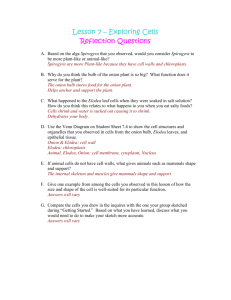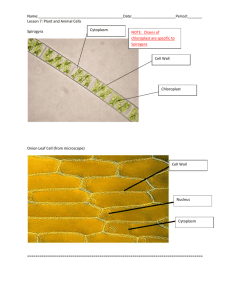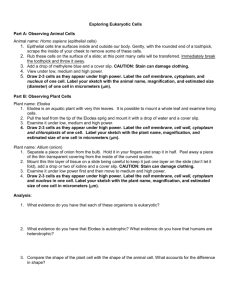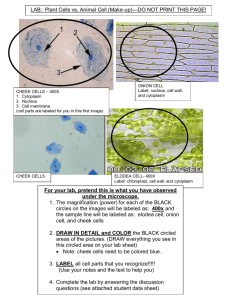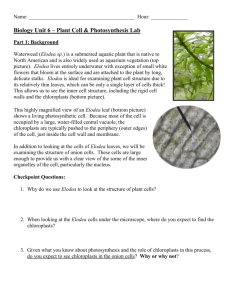Living Cells Lab
advertisement
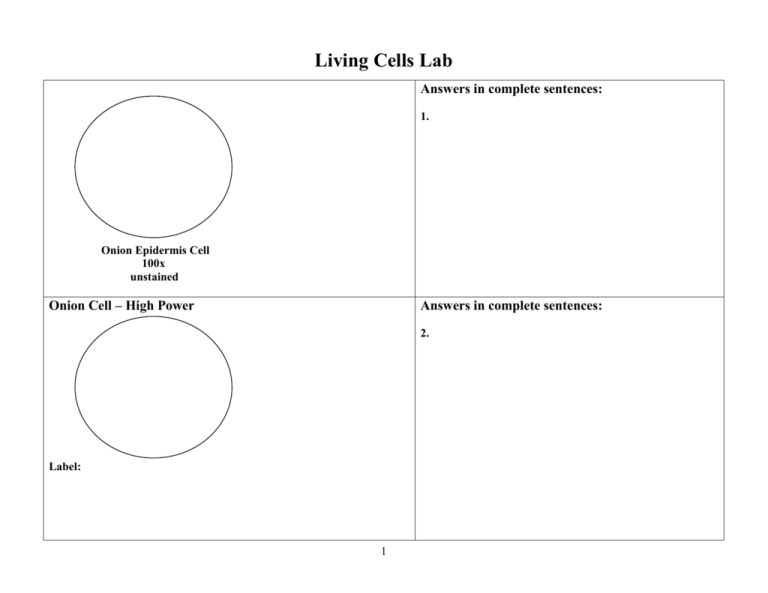
Living Cells Lab Answers in complete sentences: 1. Onion Epidermis Cell 100x unstained Onion Cell – High Power Answers in complete sentences: 2. Label: 1 Elodea Cell – High Power Answers in complete sentences: 3. 4. 5. 6. 7. Label: Onion cell Human Epidermal Cell – High Power Elodea cell Answers in complete sentences: 8. 9. Plant cell 10. Label: 11. 2 Animal cell LIVING CELLS LAB PURPOSE: To practice microscope focusing skills. To identify important structures in plant and animal cells (onion, elodea, and human epidermal cells). To make inferences about the functions of plant and animal cell structures. MATERIALS: onion elodea microscope slides and cover slips droppers tape iodine solution methylene blue solution PROCEDURE: ONION A. Obtain a small piece of the epidermis on the inner surface of the onion (concave side). B. Prepare a wet mount of the onion epidermis as follows: Place the onion epidermis on the slide and smooth out any wrinkles. Add 1 or 2 drops of water. Put on the cover slip. (Be sure the water comes to its edges, but not beyond.) C. Examine the onion epidermis under low power of your microscope. Look for cell boundaries. Then, switch to medium power. Draw: a small part of the field of view (3 cells) to show the shapes and arrangements of the cells. Label: cell wall/cell membrane, nucleus (if visible), and cytoplasm. Answer: 1. What is the general shape of the onion cells? D. Remove the slide from the microscope stage. Place a drop of iodine stain along one edge of the cover slip. Draw the stain under the cover slip by touching a piece of paper towel to the opposite edge (Figure 1). CAUTION: Stains can cause permanent damage to clothes and laboratory surfaces. Handle carefully. Figure 1. E. Place the slide on the microscope stage. Focus in low power. Then, switch to medium and high power. In high power, slowly rotate the fine focus knob and notice that different parts of the cell will focus at different times. This shows you that cells have depth. Draw: one onion cell. Include as much detail as you can see. Label: cell wall/cell membrane, nucleus (circular structure stained brown), and cytoplasm. Answer: 2. What is the shape of the nucleus? 3 ELODEA F. Elodea (sometimes called Anacharis) is a common flowering plant that lives in fresh water. The green cells of elodea are similar in structure and function to those found in other plants. Take one leaf, and place the leaf with its underside up on the slide. Add 1 drop of water and put on a cover slip. G. Observe the leaf under low power. Then, switch to medium power. By slowly turning the fine adjustment knob back and forth, determine the number of cell layers in the leaf. Answer: 3. How many cell layers are present in the leaf? H. Switch to high power. Select an “average” cell and focus on it carefully. Draw: one elodea cell. Include as much detail as you can see. Label: cell wall/cell membrane, chloroplasts, vacuole, and cytoplasm. Answer: 4. What is the evidence that the cell is living? I. Some elodea cells are packed with small green circular structures. These structures are called CHLOROPLASTS. If you look carefully, you may see some chloroplasts gliding along the edges of the cell. Answer: 5. The part of the onion from which you took cells is usually found below ground. The elodea plant is found where sunlight strikes the plant. What does this suggest about the function of chloroplasts? 6. Where are chloroplasts mainly located in the cell? Why? 7. Compare and contrast the two kinds of living cells you have seen in the Venn diagram. How are they alike? How are they different? HUMAN EPIDERMAL CELLS J. Wash the underside of a wrist that will be sampled for epidermal cells with soap and water. After drying, stick a clean piece of clear tape on the underside of the washed wrist. Gently remove the piece of tape from the wrist being careful to avoid getting fingerprints on the tape. K. Place the tape, sticky-side up, on a clean microscope slide. Add 2-3 drops of methylene blue stain. Gently place a cover slip on the sticky tape. Observe under low power. Then, switch to medium power. You may find that some of the cells are folded over or piled on top of one another. Some may be broken. Find one or two that you can see clearly. Center these for viewing. Answer: 8. What is the general shape of an epidermal cell? How does the edge of this kind of cell compare with the plant cells you observed? L. Switch to high power and find an average epidermal cell with a nucleus. Draw: one epidermal cell. Include as much detail as you can see. Label: cell membrane, nucleus, and cytoplasm. Answer: 9. How are the plant and animal cells you have seen alike? 10. Would you expect cells from other parts of your body to be exactly like the cells from your skin? Why or why not? 11. An organism may have many small cells rather than a few large cells. Suggest one or more possible explanations for this. 4

